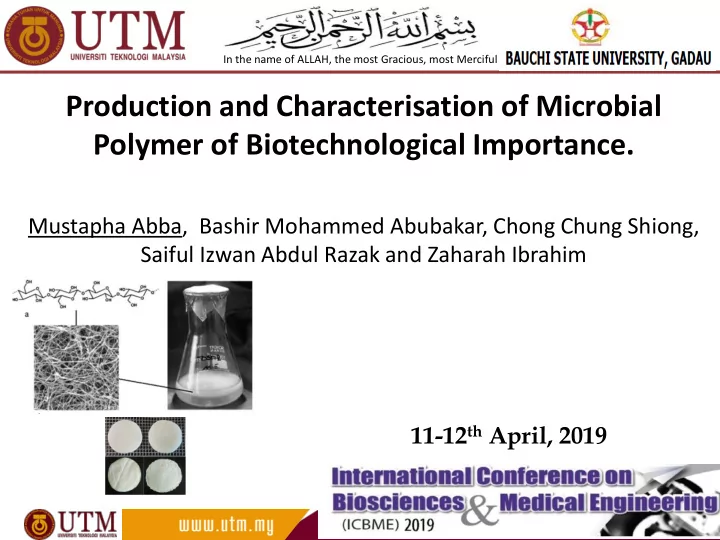

In the name of ALLAH, the most Gracious, most Merciful Production and Characterisation of Microbial Polymer of Biotechnological Importance. Mustapha Abba, Bashir Mohammed Abubakar, Chong Chung Shiong, Saiful Izwan Abdul Razak and Zaharah Ibrahim 11-12 th April, 2019
Introduction/Background of the Study With the increase in environmental awareness and limitation of resources, it is anticipated that renewable biopolymers will replace substantial fraction of synthetic and other natural polymers. Cellulosic nanomaterials provides a novel and sustainable platforms for the production of high performance biomaterials. Nanocellulose is the most abundant, renewable, natural biosorbent, and biocompatible polymer consisting of β 1-4 glycosidic linkage, frequently isolated from plants. Acetobacter, Agrobacterium , and Pseudomonas reported to secrete nanocellulose with promising properties and the same chemical structure to plant cellulose. Bacterial nanocellulose (BNC) does not contain lignin, hemicellulose, protein and other components of animal origin which are commonly found in plant nanocellulose. .
Why Bacterial Nanocellulose? High degree of High Crystallinity Index polymerisation Ultrafine Nanoscale Greater Tensile Strength Fibrous Network Properties Of BNC Pure and Free from Lignin, Pectin, and Hemicellulose In situ Foldability High value added extracellular Transparent product High Water Holding (optical) Capacity
Applications of BNC in biomedical field Novel material suitable for biofabrication in biomedical industries .
Objectives of Study To isolate and characterise nanocellulose producing bacterium To characterise BNC produced by the isolated bacterium . To evaluate the potentials of using BNC membranes biomedical applications
General flow chart Isolation and characterisation of nanocellulose producing Production and purification of BNC bacterium from fruit waste samples and its characterisation BNC production under static culture Isolation of the bacterium from fruit waste condition using modified HS samples using different growth medium medium Screening for efficient nanocellulose Purification of BNC using 0.1 M producing bacteria NaOH Molecular identification Drying and quantification Genomic DNA isolation (Wizard kits) (Freeze and Oven drying) Characterisation of BNC Agarose gel electrophoresis FTIR Nano drop analysis SEM PCR amplification (16S rRNA) TGA/DTG Gene sequence analysis (BLASTN) XRD Construction of the phylogenetic tree by neighbour joining
Results and Discussion
Isolation and Screening of Bacteria a b Fig 2 : BNC formation by the isolates Fig 1 : Pure colonies. Sphere pellets Gelatinous layer Metabolic range in addition to BNC prod. Table 1 : Biochemical characterisations Biochemical test Results/Reaction Ethanol utilisation Positive Citrate utilization Negative Lactate utilization Positive Fig 3: Utilisation of Ethanol, lactate and acetate Acetate utilization Positive using Carr medium Oxidase test Negative Catalase Positive
Molecular Identification DNA of good quality and high quantity With high molecular weight Promega kits Gene sequence analysis of the 16S RNA- Gluconacetobacter sp. – therefore named as Gluconacetobacte r sp. BCZM 1. c Fig 4 : Agarose gel electrophoresis: (a) Genomic DNA and (b) Amplified 16S rRNA gene and (c) Phylogenetic tree
BNC Production and Purification a a c Fig 4 : (a) BNC produced (static culture), (b) purified and (c) Dried BNC (freeze & oven) It was aimed to maintain the purity, The choice of drying method is equally important structure and properties of the BNC
Characterisation of BNC SEM FTIR Fig. 6: SEM images of the purified BNC Fig. 7: FTIR analysis of the purified BNC spectral 4000-400 cm -1 FTIR represents fingerprint with absorption peaks correspond to the frequencies of vibration bond of an atoms that make up the materials. Each materials has a unique combination of atoms. The signature band at 2900 cm− 1 attributing to C-H stretching vibration confirmed characteristic of native cellulose (Cheng et al ., 2009). 3500-3100 cm− 1 ( OH stretching)
Characterisation of BNC Thermogravimetric Analysis (TGA ) Fig 9. (a) TGA and (b) DTG analysis of BNC samples 1. Lost of volatile component (moisture, solvent) 2. Decomposition of the materials Peak Temperature Residual Mass at 900 BNC Sample (T max °C) °C (%) 3. Inert residues Freeze Dried 268 70.96 Maximum degradation temperature Oven dried 340 74.89 Thermally stable Residual mass in % when the char has been burn off (oxidised)
Conclusion and recommendation The isolated bacterium were identified as Gluconacetobacter sp. based on the 16S rRNA gene sequence analysis and therefore, named Gluconacetobacter sp. BCZM 1. The characterized BNC produced were found to displayed significant future for biotechnological application BNC production using bacteria could minimized nanocellulose production costs. Genetic studies on Gluconacetobacter sp. BCZM 1. to fully enhence its BNC production process. Future studies could further explore future potentials of BNC for biomedical applications. Appropriate production steps should be taken into account to maintain BNC promising properties such as 3-D structure, thermostability and fibre network,
Acknowledgement Tetfund Nigeria. Bauchi State University, Gadau, Nigeria. My research supervisors Universiti Teknologi Malaysia (UTM) Faculty of Science (UTM) Research University Grant (RUG) vote number (GUP17H51)
kera rana na me mend ndenga engar …… For r li listeni ening ng …… JAZAKUMULLAHU KHAIRAN
Recommend
More recommend